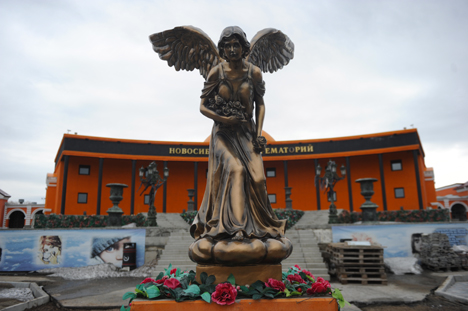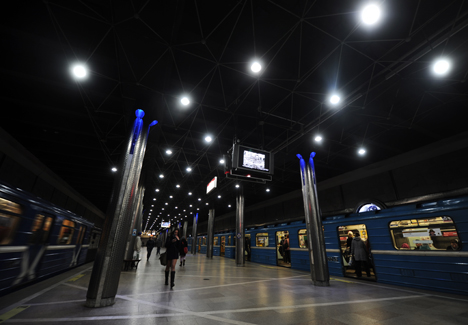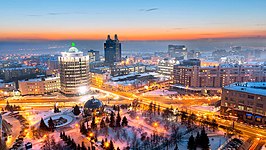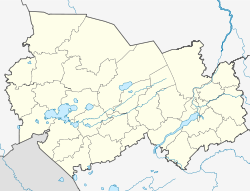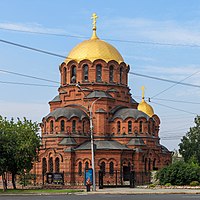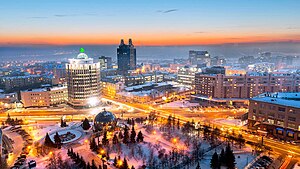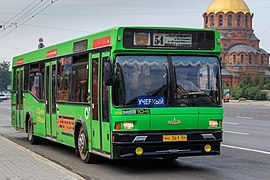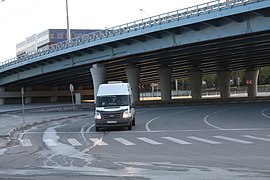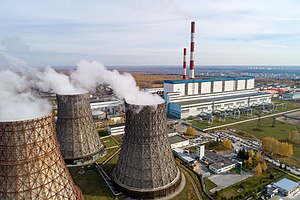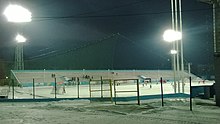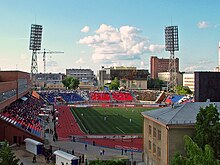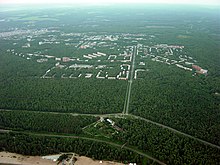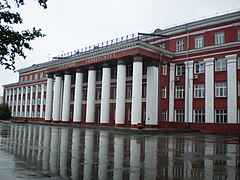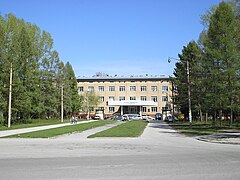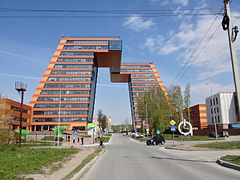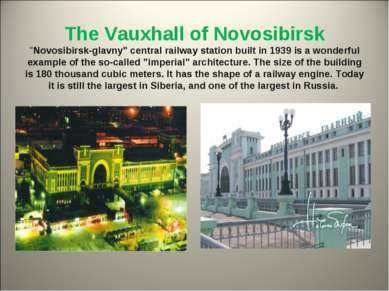Сочинение на тему «Новосибирск»на английском языке с переводом на русский язык |
|
Novosibirsk |
Новосибирск |
|
Novosibirsk is a big, beautiful and rapidly developing Russian city. It is thought to be “the capital of Siberia”, an important economic, scientific, and cultural center of this huge region. After Moscow and Saint Petersburg, Novosibirsk has the largest population among cities of Russia (over a million people). As a transport junction, Novosibirsk helps to connect European and Asian parts of the country: the Transsiberian railway passes through it. There are several universities with strong scientific base and the famous Academgorodok, where advanced biological, physical, geological researches are conducted. Numerous molls and the high-level infrastructure make Novosibirsk attractive for the youth. |
Новосибирск – большой, красивый и быстро развивающийся российский город. Он считается «столицей Сибири», важным экономическим, научным и культурным центром этого огромного края. Новосибирск имеет самое крупное население среди городов России после Москвы и Санкт-Петербурга (более миллиона человек). Как транспортный узел, Новосибирск помогает соединить европейскую и азиатскую части страны: Транссибирская магистраль проходит через него. Там находится несколько университетов с сильной научной базой и знаменитый Академгородок, где ведутся передовые биологические, физические, геологические исследования. Многочисленные торгово-развлекательные центры и инфраструктура высокого уровня делают Новосибирск привлекательным для молодёжи. |
|
The city is rather young: the first village on its territory appeared in 1893. In 1903, by the emperor’s order, the village associated with the railway station got the urban status (under the name Novo-Nikolaevsk). Afterward, the city was growing intensively, while its trading contacts, industry, education and transport were improving. The Civil War became a hard period: along with other Siberian cities, Novosibirsk tried to fight for the independence, but finally fell and suffered from communist terror. However, during the 20th century, it recovered its economy (aircraft construction, machine engineering, banks), cultural and scientific life (for example, the Siberian Branch of the Russian Academy of Sciences was opened). |
Город достаточно молод: первое село на его территории появилось в 1893 г. В 1903 г., по указу императора, село, связанное с железнодорожной станцией, получило статус города (под именем Ново-Николаевск). Впоследствии город интенсивно рос, а его торговые контакты, промышленность, образование и транспорт совершенствовались. Гражданская война стала тяжёлым периодом: наряду с другими сибирскими городами, Новосибирск пытался бороться за независимость, но в итоге пал и пострадал от коммунистического террора. Однако в ходе XX века он восстановил свою экономику (авиастроительство, машиностроение, банки), культурную и научную жизнь (например, открылось Сибирское отделение Российской Академии наук). |
|
There are many unique landmarks in Novosibirsk: monumental Alexander Nevsky Cathedral, the famous Opera and Ballet Theater, etc. Some species of animals living in the giant Novosibirsk Zoo are rare or endangered; it is possible to see there an extremely rich collection of cats. Besides, Novosibirsk hosts various festivals of poetry, music and even youth subcultures. |
В Новосибирске много уникальных достопримечательностей: монументальный Собор Александра Невского, знаменитый Театр оперы и балета и др. Некоторые виды животных, живущих в гигантском Новосибирском зоопарке, являются редкими или вымирающими; там можно увидеть чрезвычайно богатую коллекцию кошачьих. Кроме того, в Новосибирске проходят разнообразные фестивали поэзии, музыки и даже молодёжных субкультур. |
Новосибирск – город в Западной Сибири, расположен на реке Об. Это наиболее населенный город в России после Москвы и Санкт-Петербурга. Рассмотрим несколько общих фраз:
Novosibirsk [Новосибирск] – Новосибирск;
Western Siberia [вэстэрн сайбэриа] – Западная Сибирь;
- on the banks of the Ob River [он зэ бэнкс оф зэ Об риве] – На берегах реки Об.
- the most populous city in Russia after Moscow and St. Petersburg [зє мост попьюлос сити ин Раша афтэ Москов энд Сэнт-Питэсбэрг] – Новосибирск наиболее населенный город в России после Москвы и Санкт-Петербурга;
- population of 1 584 138 inhabitants [поюлейшн оф 1 584 138 инхэбитэнс] – население 1 584 138 жителей.
Novosibirsk is the city in Western Siberia, situated on the River Ob. Novosibirsk is the most populous city in Russia after Moscow and St. Petersburg . 1 584 138 inhabitants live here.
Перевод: Новосибирск – город в Западной Сибири, расположен на реке Об. Новосибирск наиболее населенный город в России после Москвы и Санкт-Петербурга. 1 584 138 жителей живут здесь.
Немного истории города:
- the city was founded in 1893 [зэ сити вэс фаундэд ин ван саузенд эйти найнти сри] – город был основан в 1893 году;
- city Building was completed in 1897 [сити билдин вэс комплитэд ин ван саузэнд найнти сэвэн) – строительство города было завершено в 1897 году;
- the city developed very quickly. In 1956, its population was 730,000 people [зэ сити дивэлопд вэри квикли. Ин найнти фифти сикс итс попльюлейшн вэс сэвэн хандрир энд сэрти саусэнд пипл] – город развивался очень быстро. В 1956 году его население становило 730 000 человек.
Сейчас Новосибирск – научный, культурный, торговый и промышленный центр. Здесь можно увидеть множество достопримечательностей, как, например:
Alexander Nevsky Cathedral – Собор Александра Невского
- first stone constructions [фэст стоун касэдрал] – перовая каменная конструкция;
- Saint Alexander Nevsky [Сэнт Алесандр Нэвски]- Святой Александр Невский;
- Orthodox Church [орзодокс чарч] – Православная церковь.
St. Alexander Nevsky Cathedral is one of the first stone constructions in Novonikolayevsk (now Novosibirsk). Its named in honor of Saint Alexander Nevsky. The church was built in 1896–1899. In 1989 the building was returned Orthodox Church
Перевод: Собор Александра Невского – первая каменная конструкция в Ново-Никалаевске (сейчас Новосибирск). Он назван в честь святого Александра Невского. Церковь была построена в 1896-1899 годах. В 1989 году здание было возвращено Православной церкви.
House officers – дом офицеров.
- in memory of the First World War heroes [ин мэмори оф зэ фэрст ворлд вар хировс] – в память героев Первой мировой войны;
- historical monument [хисторикал монумэнт]- исторический памятник;
- Olympic Glory Museum [олимпик глори мюзьем] – музей Олимпийской славы;
- military court [милитари корт] – военный суд.
This house was built in 1925. It’s a historical monument which was built in memory of the First World War heroes. Now there are a military court, a museum, a library and other facilities.
Перевод: Этот дом был построен в 1925 году. Это исторический памятник, который был построен в честь героев Первой мировой войны. Сейчас там находится военный суд, музей, библиотека и другие учреждения.
Museum of Sun – Музей Солнца.
- Museum of the Sun [мюзьем оф зэ сан] – музей солнца;
- the only museum in the world [зэ онли мюзьем ин зэ ворлд] – единственный музей в мире;
- various images [вэриос имэджэес] – различные изображения;
- private collection [прайвэт колэкшн] – частная коллекция;
- made of wood [мэйд оф вуд] – сделано с дерева.
For over 10 years in Novosibirsk there is unique Museum of the Sun. It is the only museum in the world. Here you can see various images of the sun. All exhibits are made with wood The base of the museum was a private collection of images of the Sun.
Перевод: На протяжении 10 лет в Новосибирске есть уникальный музей Солнца. Это единственный музей в мире. Здесь вы можете увидеть различные изображения солнца. Все экспонаты сделаны из дерева. Базой музея была частная коллекция изображения солнца.
Novosibirsk is the third most populated city in Russia after Moscow and St. Petersburg. It is home to exotic animals such as the liger, and in winter people practice the interesting sport of snow-kiting. Novosibirsk has many interesting places — from the home-sphere, built by young scientist, to the museum of death.
Trans-Siberian heritage
Residents of Novosibirsk love trains and are proud of the fact that their city played a significant role in the history of the grand Trans-Siberian railway, which spans the breadth of Russia. The railway is such a part of Novosibirsk identity that it is even depicted on the city’s emblem, along with the bridge that crosses the Ob river and two Siberian sables standing on their hind legs.
In the city, there are as many as five monuments to trains, and an open-air locomotive museum is located in the vicinity of the train station Seyatel’. The museum has more than 100 steam locomotives, diesel locomotives and carriages, reflecting the history of rail transportation in Russia from pre-revolutionary times to the present day. Wondering around the stationary trains and comparing your height with the diameter of the gigantic iron wheels of the first steam locomotives is all very well, but why not climb inside the carriages and see how the nobility once traveled across Russia in pre-revolutionary times? These tours will however need to be booked in advance. The museum opens from 11:00 until 17:00 every day except Mondays.
Novosibirsk spans both sides of the river Ob. In the early twentieth century, the border of two different timezones passed right through the city which led to a strange situation- morning on the east bank started one hour earlier than on the west bank! The two-kilometer covered metro bridge that crosses the river is considered the longest in the world. Due to the fluctuations in temperature across the year (on average +30 °C to -30 °C), during the summer the metro bridge expands, and in the winter it contracts by half a meter. To counter these effects, the bridge’s supports are equipped with special rollers that allow it to move.
The cultural center of Siberia
Photo credit: Lori/Legion-Media
In the centre of the city on Lenin Square lies the symbol of the city — the Novosibirsk Opera and Ballet Theatre. It is the largest theatre in Russia, and it is so vast that the Moscow Bolshoi Theatre could fit completely under its dome. The Theatre had hardly been completed when World War II started. Amongst the city’s residents, there is a myth that a bomb shelter was constructed under the theatre. Some even believe a secret bunker or possibly an entire underground city with streets and traffic lights was built so the Soviet government could be relocated in the event of the capture of Moscow by the Nazis. One urban legends says that there is an artificial underground lake beneath the theatre that could be used as a strategic reserve of drinking water or for fighting fires. However, there is no conclusive evidence about any of these tales.
The repertoire of the theatre can be viewed on its official website. The theatre season runs from September to July, and comprises mainly classical performances, like the ballet “The Nutcracker” by Tchaikovsky, Borodin’s opera “Prince Igor” and Verdi’s “La Traviata”.
The large Siberian sea and ligers
Photo credit: Alexander Kryazhev/RIA Novosti
The Ob river flows through Novosibirsk. Alongside the city a giant reservoir was dug with two dozen picturesque islands that are either inhabited or abandoned. Local residents call this place the Ob sea and use it as an urban holiday resort. A sailing regatta takes place on the reservoir, and citizens learn kite and wind surfing on the water. When the reservoir freezes over in the winter, snow-kiting becomes popular — this is skiing or snowboarding on snow-covered fields or frozen reservoirs with the aid of a kite. Snow-kiting is possible in Novosibirsk from December to February, but a lot depends on the weather as the wind must be strong enough.
Weekends are best spent at the Novosibirsk zoo. The zoo is known for breeding big cats, although surrounded by controversy, hosts a successful crossing of a tiger and lion, which of course would not otherwise breed in wildlife. Ligers, or exotic cubs of an African lion and Bengal tigress, feel quite comfortable in the Siberian climate and even produce offspring. The zoo is open to visitors year-round, seven days a week, and even has its own free mobile app, Zoo Nsk.
Every year at the beginning of January, the festival of snow culture takes place bringing together artists from across Russia and around the world to participate in a snow sculpting competition. The tradition started in 2000 inspired by the snow festival in Sapporo, Novosibirsk’s twin-city.
Siberian Silicon Valley
Photo credit: Lori/Legion-Media
One of the most famous districts of Novosibirsk is Akademgorodok built especially for the country’s best scientists. Russia’s very own Silicon Valley — Novosibirsk Technopark— is situated here and it is home to global IT companies, high-precision experimental production and two dozen research institutes involved in everything from genetics to philosophy, and from archeology to nuclear physics. New computer systems, a new laser and a vaccine against Ebola are all being developed at the Technopark.
Despite the fact that Akademgorodok was built half a century ago in the middle of the uninhabited Siberian taiga, architecturally it was ahead of its time. No trees were destroyed for its construction, and houses were built right in the middle of the forest. A man walking through the woods would seemingly stumble upon these structures. At that time, no one had built anything similar in the world and ecovillages only became fashionable much later.
For residents of the Novosibirsk Akademgorodok is a different world. When you step out the bus or car, you are immediately on one of the hiking paths through the forest, between the scientific buildings and clubs. On a walk through Akademgorodok, it is possible to unexpectedly encounter art-like objects handmade by residents of the city which have been erected as monuments and some monuments fixed up by city authorities. For example, the monument to the laboratory mice, which knits a strand of DNA on to some needles, can be found in the square alongside the Institute of Cytology and Genetics. In Akademgorodok there are many cafes and restaurants, in which it is possible to rest after a long walk. Grab a coffee and go to eat at Traveler’s Coffee, or eat lunch at the grille and bar People’s or Clover.
Winters in the Akademgorodok are slightly colder than in the city, so wrap up. Spring and summer are usually wetter, so waterproof boots are recommended. In the summer the Ob sea provides respite from the heat, so do not forget your swimsuit to go for a dip.
Memento Mori
Photo credit: ITAR-TASS/Evgeny Kurskov
The most unusual museum in Russia is located at the Novosibirsk City Crematorium near the Voskhod village of the Novosibirsk region. Crematorium owner Sergei Yakushin decided to open this unusual museum after he successfully beat cancer. According to Yakushin, his experience through that journey was the primary motivation for the creation of a museum, all the exhibits of which he collected himself.
Among the exhibits of the museum is one dedicated to world funeral culture — hearses, memorial jewellery from the hair of the deceased, samples from a specific photo-genre of «post mortem», a collection of funeral wear from the Victorian era, deathmasks, statues and monuments. There’s also an impressive collection of coffins. One of them, resembling a fish, was manufactured on a special visit to Novosibirsk by a designer coffin-maker from Africa, Eric Adjetey Anang, who specializes in the production of unusual coffins.
Surprisingly, the crematorium itself does not look at all gloomy in appearance and definitely does not look like infernal scenes from movies, or like crematoriums of other cities that gravitate towards gloomy temple aesthetics. The Novosibirsk crematorium is decorated in “cheerful” orange tones and is surrounded by a park with a children’s playground nearby. A visit to the museum then leaves you with mixed feelings.
Novosibirsk underground
Photo credit: ITAR-TASS/Evgeny Kurskov
There is only a metro system in seven Russian cities, and subterranean metros only exist in Moscow, St. Petersburg and Novosibirsk (generally, metros are called “light metros,” like in Samara.) The Novosibirsk metro was built in some of the most unforgiving conditions as the land in this area is often frozen throughout the year.
Tourists from all over the world go down into the Moscow metro to take a ride and a few selfies in the most famous underground museum. The Novosibirsk metro is also quite a museum in itself — it has 13 stations, the most beautiful of which is Gagarinskaya, Sibirskaya and Rechnoy Vokzal.
The ultramodern Gagarinskaya station is like a real cosmos underground. Its technologically themed design includes marble walls with metallic elements, dark blue backlighting and portraits of Yuri Gagarin. The Sibirskaya station looks like an underground treasure trove, decorated by Altai masters craftsmen with mosaics of precious Siberian stones. The Rechnoy Vokzal station is framed with ten glowing stained glass windows depicting the largest cities of Siberia, including Novosibirsk itself, Omsk, Barnaul and others. The platform resembles a big ship sailing on the Ob, from which ancient Siberian cities are visible through its windows.
How to get there
The easiest way to get to Novosibirsk is by plane with Aeroflot or Novosibirsk airline S7 with one-way tickets from Moscow costing from 200-250 USD. If you decide to take from the train from Moscow, you’ll have to travel approximately a third of the Trans-Siberian Railway. That’s 3,300 kilometers over almost a three-day journey.
Where to stay
There are many great hotels in Novosibirsk. Amongst the best include a four-star Doubletree hotel by Hilton, which is located near Lenin Square (per room from $200). After renovations and repairs, the congress-hotel Novosibirsk has improved (per room from $100) and is located across from the train station. Less expensive but of a similar standard is the four-star River Park hotel near Rechnoy Vokzal metro station, which costs $80 per night.
All rights reserved by Rossiyskaya Gazeta.
Get the week’s best stories straight to your inbox
Novosibirsk is Russia’s scientific centre. The city hosts over 100 R&D organizations, a science campus, the General Committee of the Siberian Branch of the Russian Academy of Sciences. Over 1,500 doctors of science and 3,400 candidates of science live and work here.
The Most Rapidly Growing City of the World
Novosibirsk is the third largest city in Russia by population, the most rapidly growing million-plus city in the world, and is inhabited by representatives of over twenty nationalities. Orthodox churches and cathedrals neighbour mosques, a Catholic cathedral, a synagogue, a Buddhist cathedral, and other religious establishments and centres.
City of Sports
Both professional and amateur sports are well developed in Novosibirsk. The city has eight stadiums, sporting facilities, alpine skiing and biathlon complexes, alpine ski camps, a snowboard park, swimming pools, a motordrome and a go-kart track. Novosibirsk is a frequent venue for national and international contests, including annual biathlon and Greco-Roman wrestling tournaments. Many sports entertainment events are held here, including the municipal wellness festival.
City of Culture
Cultural events of national and international levels are held in Novosibirsk every year: fantasy festivals (White Spot), documentaries (Meetings in Siberia), youth subcultures (Znaki), celtic music and dances (Anima Celtica), snow figures, ethnic cultures, street theatres (Three Crows), a light show (Siberian Light), jazz (Sib Jazz Fest), craft beer festivals (CraftFest), and others. Novosibirsk Opera and Ballet Theatre is one of Russia’s leading musical theatres, a multifaceted architectural complex with the status of a Russian object of cultural heritage. Its troupe regularly takes part in national and international festivals and has won a number of professional rewards. A variety of festivals and concerts (including experimental music events) is held at the Globus Youth Theatre.
City of Cinema Lovers
Novosibirsk is a real gem for cinema lovers. Besides the regular cinemas, there are a number of alternative venues here, including the auto theatre and two cinema clubs where you can discuss movies with like-minded fans. A local anti-cafe holds night movie shows. Cinemas are also shown atop a number of multi-storey buildings.
Dynamic City
Novosibirsk is a wonderful place for those who enjoy the active lifestyle. There are several bike rental spots here, and you can also take a guided bike tour around the suburbs. You can rent a bike, roller skates, ice skates, and skis in Zaeltsovsky Park and the Botanical Garden. Novosibirsk offers at least seven spots with running tracks in picturesque parks and gardens for those fond of a morning jog. Workout (street fitness) fans gather at sports grounds with chin-up bars and gymnastic equipment.
What to See
One of the Longest Straight Streets in the World
The length of Krasny Prospect (the central street of Novosibirsk) stretches to almost 7 km.
The Longest Underground Bridge in the World
An underground bridge across the River Ob connects two stations of the Novosibirsk underground: Studencheskaya and Rechnoy Vokzal. The total length of the structure is 2,145 metres.
Near the City
The suburbs of Novosibirsk are very beautiful. Among sites worth visiting are the Barsukovskaya Peschera (Badger’s Cave, with some arches 200 metres long), the Belovsky Waterfall, Lake Glubokoye, and Umrevinsky Pit (a fortress from the early 18th century). Berdsky Rocks are one of the most beautiful tourist destinations of Siberia. Bugotaksky peaks are also quite an attraction for those who enjoy hiking.
Fans of active recreation will always find something to do here. You can rent a 4-wheeler or Segway, visit a rope park or a climbing wall, practice parachuting or take a flight in an air tunnel.
There are several recreation camps near Novosibirsk for fishing fans.
Several equestrian clubs operate in the city and its suburbs and offer horse riding lessons, guided tours, and photo sessions with these beautiful animals.
|
Novosibirsk Новосибирск |
|
|---|---|
|
City[1] |
|
|
Top to bottom, left to right: Novosibirsk skyline in winter, the Opera and Ballet Theatre, the Railway station, the Circus, the Trade House, and the Alexander Nevsky Cathedral |
|
|
Flag Coat of arms |
|
|
Location of Novosibirsk |
|
|
Novosibirsk Location of Novosibirsk Novosibirsk Novosibirsk (Novosibirsk Oblast) |
|
| Coordinates: 55°03′N 82°57′E / 55.050°N 82.950°ECoordinates: 55°03′N 82°57′E / 55.050°N 82.950°E | |
| Country | Russia |
| Federal subject | Novosibirsk Oblast[2] |
| Founded | 1893[3] |
| City status since | January 10, 1904 [O.S. December 28, 1903][4] |
| Government | |
| • Body | Council of Deputies[5] |
| • Head (Mayor)[5] | Anatoly Lokot[6] |
| Area
[7] |
|
| • Total | 502.7 km2 (194.1 sq mi) |
| Elevation | 150 m (490 ft) |
| Population
(2010 Census)[8] |
|
| • Total | 1,473,754 |
| • Estimate
(2018)[9] |
1,612,833 (+9.4%) |
| • Rank | 3rd in 2010 |
| • Density | 2,900/km2 (7,600/sq mi) |
|
Administrative status |
|
| • Capital of | Novosibirsk Oblast[2], City of Novosibirsk[10] |
|
Municipal status |
|
| • Urban okrug | Novosibirsk Urban Okrug[11] |
| • Capital of | City of Novosibirsk[12], Novosibirsky Municipal District[13] |
| Time zone | UTC+7 (MSK+4 |
| Postal code(s)[15] |
List 630000, 630001, 630003–630005, 630007–630011, 630015, 630017, 630019, 630020, 630022, 630024, 630025, 630027–630030, 630032–630037, 630039–630041, 630045–630049, 630051, 630052, 630054–630061, 630063, 630064, 630066, 630068, 630071, 630073, 630075, 630077–630080, 630082–630084, 630087–630092, 630095–630100, 630102, 630105–630112, 630114, 630116, 630117, 630119–630121, 630123, 630124, 630126, 630128, 630129, 630132, 630133, 630136, 630200, 630201, 630700, 630880, 630885, 630890, 630899–630901, 630910, 630920–630926, 630970–630978, 630980–630983, 630985, 630988, 630989, 630991–630993, 901026, 901036, 901073, 901076, 901078, 901095, 901243, 901245, 901246, 991214 |
| Dialing code(s) | +7 383[16] |
| OKTMO ID | 50701000001 |
| City Day | Last Sunday of June[17] |
| Website | www.novo-sibirsk.ru |
Novosibirsk (, also ;[18][19] Russian: Новосиби́рск, IPA: [nəvəsʲɪˈbʲirsk] (listen)) is the largest city and administrative centre of Novosibirsk Oblast and Siberian Federal District in Russia. As of the 2021 Census, it had a population of 1,633,595,[20] making it the most populous city in Siberia and the third-most populous city in Russia. The city is located in southwestern Siberia, on the banks of the Ob River.[21]
Novosibirsk was founded in 1893 on the Ob River crossing point of the future Trans-Siberian Railway, where the Novosibirsk Rail Bridge was constructed. Originally named Novonikolayevsk (Pre-reform orthography: Ново-Николаевскъ, IPA: [ˈnovə nʲɪkɐˈla(j)ɪfsk]; «New Nicholas») in honor of Emperor Nicholas II, the city rapidly grew into a major transport, commercial, and industrial hub. Novosibirsk was ravaged by the Russian Civil War but recovered during the early Soviet period and gained its present name, Novosibirsk («New Siberia»), in 1926. Under the leadership of Joseph Stalin, Novosibirsk became one of the largest industrial centers of Siberia. Following the outbreak of World War II, the city hosted many factories relocated from the Russian core.
Novosibirsk is home to numerous Russian corporations, the neo-Byzantine Alexander Nevsky Cathedral, the Novosibirsk Opera and Ballet Theatre, as well as the Novosibirsk Zoo. It is served by Tolmachevo Airport, the busiest airport in Siberia.[22]
History[edit]
Novonikolayevsk in 1895
Novosibirsk was founded on the right side of the Ob, near an area traditionally inhabited by Chat Tatars (Chertovo gorodishche [ru]). The Russian town originated on 30 April 1893[3] at the future site of a Trans-Siberian Railway bridge crossing the great Siberian river, the Ob, and in 1895 became known as Novonikolayevsk (Новониколаевск),[4] in honor both of Saint Nicholas[citation needed] and of the new reigning Tsar, Nicholas II.[23] It superseded Bolshoye Krivoshchyokovo village, located on the opposite side of the Ob, which was founded in 1696 and was resettled in 1893 due to the construction of the Novosibirsk Rail Bridge. The bridge, completed in the spring of 1897, made the new settlement a regional transport hub. The importance of the city further increased with the completion of the Turkestan–Siberia Railway in the early 20th century. The new railway connected Novonikolayevsk directly with Central Asia and the Caspian Sea.[24]
At the time of the bridge’s opening, Novonikolayevsk had a population of 7,800 people. The settlement developed rapidly. Its first bank opened in 1906, and a total of five banks were operating by 1915. In 1907, Novonikolayevsk, now with a population exceeding 47,000, was granted town status with full rights for self-government. During the pre-revolutionary period, the population of Novonikolayevsk reached 80,000. The city had steady and rapid economic growth, becoming one of the largest commercial and industrial centers of Siberia. It developed a significant agricultural-processing industry,[25] as well as a power station, iron foundry, commodity market, several banks, and commercial and shipping companies. By 1917, the city had seven Orthodox churches and one Roman Catholic Church, along with several cinemas, forty primary schools, a high school, a teaching seminary, and the Romanov House non-classical secondary school. In 1913, Novonikolayevsk became one of the first places in Russia to institute compulsory primary education.[24]
The Russian Civil War of 1917-1923 took a toll on the city. Wartime epidemics, especially typhus and cholera, claimed thousands of lives. In the course of the war, the Ob River Bridge was destroyed. For the first time in the city’s history, the population of Novonikolayevsk began to decline. The Soviet Workers’ and Soldiers’ Deputies of Novonikolayevsk took control of the city in December 1917. In May 1918, the Czechoslovak Legion rose in opposition to the revolutionary government and, together with the White Guards, captured Novonikolayevsk (26 May 1918). The Red Army took the city in 1919, retaining it throughout the rest of the Civil War.[24]
Novonikolayevsk began reconstruction in 1921 at the start of Lenin’s New Economic Policy period (1921-1928). The city formed part of Tomsk Governorate and served as its administrative center from 23 December 1919 to 14 March 1920. Between 13 June 1921 and 25 May 1925, it served as the administrative center of Novonikolayevsk Governorate [ru], which was separated from Tomsk Governorate.[citation needed] The city received its present name on 12 September 1926,[4] —Novosibirsk, which, in the Russian language, translates roughly as «New Siberian [town]».
After the Soviet Union abolished governorates in 1929, the city served as the administrative center of the Siberian Krai until 23 July 1930, and of West Siberian Krai until 28 September 1937, when that krai was split into Novosibirsk Oblast and Altai Krai.[26] Since then, it has served as the administrative center of Novosibirsk Oblast.[26]
View of the part of Student Brigades Square and the intersection of Oktyabrskaya Highway, Serebrennikovskaya Street and Oktyabrskaya Street, as seen in 2017. In the lower left-hand corner, the part of the building of the Novosibirsk Globus Theatre is visible. In the center of the picture, you can see the building at 50 Kommunisticheskaya Street, popularly known as «Batman» and «Plug».[27]
The Monument to the Heroes of the Revolution, erected in the center of the city in 1922, became one of the chief historic sites (essentially every child had to visit the monument on school field-trips during the Soviet years). Neglect in the 1990s while other areas were redeveloped helped preserve it in the post-Soviet era.[citation needed]
During Stalin’s industrialization effort, Novosibirsk secured its place as one of the largest industrial centers of Siberia. Several massive industrial facilities developed, including the ‘Sibkombain’ plant, specializing in the production of heavy mining equipment. Additionally, a metal-processing plant, a food-processing plant, and other industrial enterprises and factories were built, as well as a new power station. The great Soviet famine of 1932–33 resulted in more than 170,000 rural refugees seeking food and safety in Novosibirsk. They were settled in barracks at the outskirts of the city, giving rise to slums.[24] Its rapid growth and industrialization led to Novosibirsk being nicknamed the «Chicago of Siberia».[28]
Tram rails were laid down in 1934, by which time the population had reached 287,000, making Novosibirsk the largest city in Siberia. The following year the original road bridge over the Ob River was replaced by the new Kommunalny bridge.[24]
Between 1941 and 1942 the Soviets crated up and relocated more than 50 substantial factories from western Russia to Novosibirsk in order to reduce the risk of their destruction through war, and at this time the city became a major supply base for the Red Army. During this period the city also received more than 140,000 refugees.[citation needed]
The rapid growth of the city prompted the construction during the 1950s of a hydroelectric power station with a capacity of 400 megawatts,[29] necessitating the creation of a giant water reservoir, now known as the Ob Sea. As a direct result of the station’s construction, vast areas of fertile land were flooded, as were relic pine woods in the area; additionally, the new open space created by the reservoir’s surface caused average wind speeds to double, increasing the rate of soil erosion.[24]
In the 1950s, the Soviet Government directed the building of a center for scientific research in Novosibirsk, and in 1957 the multi-facility scientific research complex of Akademgorodok was constructed about 30 km (19 mi) south of the city center. The Siberian Division of the Russian Academy of Sciences (formerly the Academy of Sciences of the Soviet Union) has its headquarters in Akademgorodok, and the town hosts more than 35 research institutes and universities, among them Novosibirsk State University, one of the top Russian schools in natural sciences and mathematics. Although it possesses a fully autonomous infrastructure, Akademgorodok is administered by Novosibirsk.[citation needed]
On 2 September 1962, the population of Novosibirsk reached one million. At that time, it was the youngest city in the world with the population exceeding one million. Novosibirsk took fewer than seventy years to achieve this milestone.[30] On 8 June 1965, the city was the scene of a dramatic aerial stunt when Lieutenant Valentin Privalov flew his MiG-17 under the October Bridge; an image which purportedly showed the event was later found to be a photocollage.[31][32] In 1979, work began on the Novosibirsk Metro Transit System, culminating in the opening of the first line in 1985.[24]
On 1 August 2008, Novosibirsk was in the center of the path of a solar eclipse, with a duration of 2 minutes and 20 seconds.[citation needed]
Administrative and municipal status[edit]
Novosibirsk is the administrative center of the oblast[2] and, within the framework of administrative divisions, it also serves as the administrative center of Novosibirsky District,[1] even though it is not a part of it.[10] As an administrative division, it is incorporated separately as the City of Novosibirsk[10]—an administrative unit with the status equal to that of the districts.[citation needed] As a municipal division, the City of Novosibirsk is incorporated as Novosibirsk Urban Okrug.[11]
City districts[edit]
- Dzerzhinsky (Дзержинский)
- Kalininsky (Калининский)
- Kirovsky (Кировский)
- Leninsky (Ленинский)
- Oktyabrsky (Октябрьский)
- Pervomaysky (Первомайский)
- Sovetsky (Советский)
- Tsentralny (Центральный)
- Zayeltsovsky (Заельцовский)
- Zheleznodorozhny (Железнодорожный)
Demographics[edit]
| 1979 Census | 1,312,480[33] |
|---|---|
| 1989 Census | 1,436,516[34] |
| 2002 Census | 1,425,508[35] |
| 2010 Census | 1,473,754[8] |
According to the Federal State Statistics Service, in January 2021 the number of residents came to 1,620,162.[36] This is an increase compared to the 2010 census, when the population of the city was 1,473,754.[8]
People from over eighty ethnicities and nationalities reside in Novosibirsk. The largest groups are Russian, Ukrainian, Uzbek, Tatar, German, and Tajik.[37]
Ecology[edit]
Flora[edit]
The best-known trees native to Novosibirsk are birch, pine, and aspen. Some mountain ash, hawthorn, spruce, and fir are also present. European species of apple, ash, elm, linden, and oak have been successfully introduced.[citation needed]
Geography[edit]
Urban layout[edit]
The layout of the modern city is based on the planning of the post-revolution period. Before 1917, there was no traditional city center in Novo-nikolayevsk. The main buildings of the railway management and the nearby railway station as well as the most important cathedral and the complex of the city’s government were spread throughout the city. This changed following the revolution, with Lenin House built in 1925 in what was traditionally the main avenue, Krasny Prospekt while the first Lenin monument was built in Barnaulskaya Street, closer to the railway station. And thus, until the late 1920s, Novosibirsk did not have a clearly defined city center. The 1930s brought many changes to the development of the city: Its former Bazarnaya Ploschad (Market Square) was chosen as the site for the construction of the Opera House which started in 1931. The Stalin Park of Culture and Rest was established some distance from the main avenue and the city’s administrative buildings and park created a radial around the Bazarnaya Ploschad.[38]
Location[edit]
The city stands on the banks of the Ob River in the West Siberian Plain. To the south of the city lies the Priobskoye Plateau. The nearest major cities are Barnaul,[39] Krasnoyarsk, Omsk and Astana.[citation needed]
Climate[edit]
The climate in Novosibirsk is typical of Siberia, with dry winters and far-below-freezing winter temperatures. Among the reasons for these temperatures are the absence of a nearby ocean and the lack of tall mountains at the north of Novosibirsk that could have held back freezing Arctic winds.[citation needed] In fact, Novosibirsk is the second-farthest substantially populated city from the ocean, the first being Ürümqi in China.[citation needed]
The climate is humid continental (Köppen Dfb), with warm summers and bitterly cold winters. Snow is frequent, falling on almost half of all winter days, but individual snowfalls are usually light. On average temperatures range in summer from +15 °C (59 °F) to +26 °C (79 °F) and in winter from −20 °C (−4 °F) to −12 °C (10 °F). However, winter temperatures can go as low as −30 °C (−22 °F) to −35 °C (−31 °F), and summer temperatures can go as high as +30 °C (86 °F) to +35 °C (95 °F). The difference between the highest- and lowest-recorded temperatures is 82 °C (148 °F).
Travellers coming from countries with mild climates may find Novosibirsk’s winter extremely cold, but it is a lot less severe than further east in Siberia and the Russian Far East, especially considering its latitude of 55°N. For example, Novosibirsk is less cold during winter nights than Spassk-Dalny at eleven degrees lower latitude. It also is less cold in winter than the largest far eastern city of Khabarovsk and during nights even the Pacific coastal town of Sovetskaya Gavan, both underneath 49°N. At times, bitter cold may hold for some days, but temperatures of −40 °C (−40 °F) and lower do not occur every year.
| Climate data for Novosibirsk (1991–2020, extremes 1930–present) | |||||||||||||
|---|---|---|---|---|---|---|---|---|---|---|---|---|---|
| Month | Jan | Feb | Mar | Apr | May | Jun | Jul | Aug | Sep | Oct | Nov | Dec | Year |
| Record high °C (°F) | 4.1 (39.4) |
5.1 (41.2) |
14.4 (57.9) |
30.7 (87.3) |
36.1 (97.0) |
36.6 (97.9) |
36.4 (97.5) |
35.7 (96.3) |
33.2 (91.8) |
23.8 (74.8) |
11.7 (53.1) |
4.8 (40.6) |
36.6 (97.9) |
| Average high °C (°F) | −12.6 (9.3) |
−9.2 (15.4) |
−1.3 (29.7) |
9.6 (49.3) |
18.9 (66.0) |
23.8 (74.8) |
25.4 (77.7) |
23.1 (73.6) |
16.1 (61.0) |
7.9 (46.2) |
−3.4 (25.9) |
−9.9 (14.2) |
7.4 (45.3) |
| Daily mean °C (°F) | −17.0 (1.4) |
−14.4 (6.1) |
−6.8 (19.8) |
3.6 (38.5) |
11.9 (53.4) |
17.6 (63.7) |
19.5 (67.1) |
16.9 (62.4) |
10.3 (50.5) |
3.3 (37.9) |
−6.8 (19.8) |
−13.9 (7.0) |
2.0 (35.6) |
| Average low °C (°F) | −21.2 (−6.2) |
−19.1 (−2.4) |
−11.9 (10.6) |
−1.4 (29.5) |
5.7 (42.3) |
11.7 (53.1) |
13.9 (57.0) |
11.5 (52.7) |
5.7 (42.3) |
−0.2 (31.6) |
−10.1 (13.8) |
−18 (0) |
−2.8 (27.0) |
| Record low °C (°F) | −46.2 (−51.2) |
−46.3 (−51.3) |
−36.4 (−33.5) |
−29 (−20) |
−8.6 (16.5) |
−2.0 (28.4) |
3.9 (39.0) |
0.2 (32.4) |
−6.9 (19.6) |
−26.4 (−15.5) |
−39.6 (−39.3) |
−45.7 (−50.3) |
−46.3 (−51.3) |
| Average precipitation mm (inches) | 25 (1.0) |
18 (0.7) |
20 (0.8) |
24 (0.9) |
37 (1.5) |
55 (2.2) |
68 (2.7) |
58 (2.3) |
46 (1.8) |
43 (1.7) |
39 (1.5) |
36 (1.4) |
469 (18.5) |
| Average rainy days | 1 | 1 | 2 | 8 | 13 | 14 | 14 | 14 | 16 | 12 | 5 | 1 | 101 |
| Average snowy days | 23 | 19 | 15 | 9 | 3 | 0.1 | 0 | 0 | 1 | 11 | 20 | 25 | 126 |
| Average relative humidity (%) | 82 | 81 | 77 | 65 | 58 | 66 | 73 | 75 | 75 | 78 | 83 | 83 | 75 |
| Mean monthly sunshine hours | 67 | 107 | 166 | 213 | 264 | 302 | 304 | 245 | 170 | 100 | 58 | 45 | 2,041 |
| Source 1: Pogoda.ru.net[40] | |||||||||||||
| Source 2: Danish Meteorological Institute (sun, 1931–1960)[41] |
| Climate data for Novosibirsk (1961-1990) | |||||||||||||
|---|---|---|---|---|---|---|---|---|---|---|---|---|---|
| Month | Jan | Feb | Mar | Apr | May | Jun | Jul | Aug | Sep | Oct | Nov | Dec | Year |
| Average high °C (°F) | −12.2 (10.0) |
−10.3 (13.5) |
−2.6 (27.3) |
8.1 (46.6) |
17.5 (63.5) |
24.0 (75.2) |
25.7 (78.3) |
22.2 (72.0) |
16.6 (61.9) |
6.8 (44.2) |
−2.9 (26.8) |
−8.9 (16.0) |
7.0 (44.6) |
| Daily mean °C (°F) | −16.2 (2.8) |
−14.7 (5.5) |
−7.2 (19.0) |
3.2 (37.8) |
11.6 (52.9) |
18.2 (64.8) |
20.2 (68.4) |
17.0 (62.6) |
11.5 (52.7) |
3.4 (38.1) |
−6.0 (21.2) |
−12.7 (9.1) |
2.4 (36.3) |
| Average low °C (°F) | −20.1 (−4.2) |
−19.1 (−2.4) |
−11.8 (10.8) |
−1.7 (28.9) |
5.6 (42.1) |
12.3 (54.1) |
14.7 (58.5) |
11.7 (53.1) |
6.4 (43.5) |
0.0 (32.0) |
−9.1 (15.6) |
−16.4 (2.5) |
−2.3 (27.9) |
| Average precipitation mm (inches) | 19 (0.7) |
14 (0.6) |
15 (0.6) |
24 (0.9) |
36 (1.4) |
58 (2.3) |
72 (2.8) |
66 (2.6) |
44 (1.7) |
38 (1.5) |
32 (1.3) |
24 (0.9) |
442 (17.4) |
| Source: «Mean monthly climatic data for the city of Novosibirsk from 1961 to 1990». Roshydromet. Retrieved October 17, 2010. |
Broadcasting[edit]
Novosibirsk is home to Russia’s most powerful shortwave relay station east of the Ural mountains. This relay station can reach most of South Asia, the Middle East, and China. The Magadan and Vladivostok relay stations when operated in conjunction with Novosibirsk can guarantee that the Voice of Russia or any other broadcaster renting time at Novosibirsk is heard in the intended target area.
Transportation[edit]
International and intercity transportation[edit]
Airports[edit]
The city is served by Novosibirsk Tolmachevo Airport, which connects Novosibirsk with most of Russia’s largest cities and most countries of Europe and Asia. Tolmachevo is the hub for S7 Airlines.
There is also the auxiliary Yeltsovka Airport.
A smaller field for general aviation at Novosibirsk Severny Airport was closed in 2012. In August 2008, the First World Aerobatics Championship in Yak-52 aircraft was held at the airport.[42]
Railway stations[edit]
Trains at Novosibirsk-Glavny railway station
Novosibirsk is a major stop on the Trans-Siberian Railway and the north end of Turkestan–Siberia Railway. The main railway station of Novosibirsk is Novosibirsk-Glavny station («Glavny» means «Main») which is located in the centre of the right bank part of the city. There are also Novosibirsk-Zapadny («Zapadny» means «Western»), Novosibirsk-Vostochny («Vostochny» means «Eastern»), and Novosibirsk-Yuzhny («Yuzhny» means «Southern») railway stations in Novosibirsk. All intercity trains passing through the aforementioned stations stop at these stations. In addition, there are halts where only suburban trains stops, for example Inskaya, Seyatel, Razyezd Inya, and many others.
The many regular intercity trains connect Novosibirsk with Russian cities in Siberia, the Far East, Ural, and European Russia. International trains connect the city with China, Mongolia, Belarus, and countries in Central Asia.
Bus stations[edit]
The old Novosibirsk Bus Station located on Krasny Avenue in the right bank part of the city near Kommunalny Bridge was opened in 1964 and eventually closed on 6 April 2020.[43] There is a plan to build some new bus stations on the periphery of the city; the first of these new bus stations was built on Gusinobrodskoe Сhaussee and was opened on 18 December 2019.[44] Until the completion of remaining new bus stations, some bus stops in the city are being used by intercity bus services.
The many regular intercity/international bus routes connect Novosibirsk with most cities of the southern part of Western Siberia and major cities of Central Asia.
River passenger terminals[edit]
The building of Novosibirsk river passenger terminal (Russian: Речной вокзал) on the Ob river was opened in 1974.[45] Later, the self-titled metro station was opened near the building of the terminal. On 7 March 2003, there was the strong fire in the building of the terminal.[46] The part of the building was beyond repair and was demolished.
At present day, only two regular passenger lines are operational: Novosibirsk — Kudryash island — Yagodnaya — Cheremushki — Novaya Zarya — Bibikha — Sedova Zaimka and Novosibirsk — Berdsk.[47] There are also cruises on the Ob river and the Novosibirsk Reservoir including to Tomsk and Barnaul.
Usually, the period of navigability is opened in late April or early May and is closed in late September or early October.
City public transportation[edit]
Metro[edit]
Сhronologically, Novosibirsk was the fourth city in Russia in which a metro system was established, after Moscow, Saint Petersburg, and Nizhny Novgorod. It was therefore also the first city in Siberia. The Novosibirsk Metro was opened in 1985. As of 2022, the system has 2 dual track lines (Leninskaya (Red) and Dzerzhinskaya (Green)) and 13 stations.[48]
Tram system[edit]
The Novosibirsk tram system was launched in 1934. As of 2022, the network has 10 routes: 6 of them are situated in left-bank part of the city, 4 of them are situated in right-bank of the city.[49][50]
Trolleybus system[edit]
The Novosibirsk trolleybus system was launched in 1957. As of 2022, the network has 14 routes.[51][50]
Bus system[edit]
The Novosibirsk bus system was launched in 1923. As of 2022, system consists of 52 routes served by buses over 10 metres long and 17 routes served by smaller buses.[52]
Route taxi[edit]
The Novosibirsk route taxi system (marshrutka) have operated in the city since late 1970s. In 1989, first private carriers appeared. Since 1990s only private route taxis carriers have been existing.[53] There are 56 marshrutkas routes in Novosibirsk.[54]
Waterbus system[edit]
As of 2021, the Novosibirsk waterbus system includes the following routes:[47]
- Novosibirsk river passenger terminal — Beach «Bugrinskaya Roshcha» — Korablik Island
- Novosibirsk river passenger terminal — Severo-Chemskoy residential area — Allotment garden community «Smorodinka» — Allotment garden community «Tikhie Zori»
- Novosibirsk river passenger terminal — Novosibirsk Waterpark (the last route was not included in the plan of navigational season 2021 due to suspension of Waterpark’s operation).
Usually, the period of navigability is opened in late April or early May and is closed in late September or early October.[citation needed]
-
Marshal Pokryshkin metro station
-
-
Trolza-5265 low-floor trolleybus
-
MAZ-103 low-entry bus
-
Economy[edit]
Novosibirsk CHP Station-5
Novosibirsk is a large industrial center. The industrial complex consists of 214 large and average-sized industrial enterprises. These produce more than two-thirds of all industrial output of the Novosibirsk region. Leading industries are aerospace (Chkalov’s Novosibirsk Aircraft Plant), nuclear fuel (Novosibirsk Chemical Concentrates Plant), turbo and hydroelectric generators (NPO ELSIB), textile machinery (Textilmach), agriculture machinery (NPO «Sibselmash»), electronics components and devices production (Novosibirsk Factory and Design Bureau of Semiconductor Devices NZPP, OXID Novosibirsk Plant of Radio components), and metallurgy and metalworking (Kuzmina’s Novosibirsk Metallurgical Plant, Novosibirsk Tin Plant OJSC, and JSC Plant of Rare Metals).
According to the television station RBC, Novosibirsk took third place in 2008 in the list of Russian cities most attractive to businesses (in 2007 it was placed thirteenth).
The Rich Family multi-national retailer was founded in Novosibirsk in 2002 and continues to maintain their headquarters in the city. Before the relocation of its headquarters to Ob, S7 Airlines had its head office in Novosibirsk.[55]
The headquarters of a number of large Russian companies are located in Novosibirsk:[56]
- RATM Holding
- Novosibirsk Aircraft Production Association Plant (NAPO) (a subsidiary of Sukhoi)
- Belon
- Center of Financial Technologies
- Siberian Coast Food Company (until 2009)
- NETA IT Company (retail, system integrator, software sales)
- Parallels IT Company (software for virtualization)
- Inmarko Food Company
- Siberian Food Corporation
- Electro-vacuum plant (the largest glass bottle factory in the Asian part of the country)
- NPO NIIIP-NZiK
- 2GIS
Sports[edit]
Several professional sports clubs are active in the city:
| Club | Sport | Founded | Current league | League rank |
Stadium |
|---|---|---|---|---|---|
| FC Novosibirsk | Football | 1936 | Russian Professional Football League | 3rd | Spartak Stadium |
| Sibir Novosibirsk | Ice hockey | 1962 | Kontinental Hockey League | 1st | Ice Sports Palace Sibir |
| Sibselmash Novosibirsk | Bandy | 1937 | Russian Bandy Super League | 1st | Sibselmash Stadium |
| BC Novosibirsk | Basketball | 2011 | Basketball Super League | 2nd | SKK Sever |
| Dynamo-GUVD Novosibirsk | Basketball | 1955 | Women’s Basketball Premier League | 1st | SKK Sever |
| Lokomotiv Novosibirsk | Volleyball | 1977 | Volleyball Super League | 1st | Lokomotiv-Arena |
| Sibiryak Novosibirsk | Futsal | 1988 | Futsal Super League | 1st | NSAAA Sports Hall |
Novosibirsk is the home town of several former Olympians, including Aleksandr Karelin, a twelve-time world Greco-Roman wrestling champion who has been voted the greatest Greco-Roman wrestler of the twentieth century by the sport’s international governing body of FILA.
The city also hosts a number of National and International Ice Speedway events. Siberia Novosibirsk competed in the Russian Ice Speedway Premier League in 2012/13, and will do so again in 2013/2014.
Music[edit]
Several contemporary classical violinists, such as Vadim Repin, the late Alexander Skwortsow, Natalia Lomeiko, and Maxim Vengerov, are natives of Novosibirsk. Also born in the city were punk legend, poet and singer-songwriter Yanka Dyagileva, tragic punk rocker Dmitry Selivanov, folk/folk-rock singer Pelageya Khanova, and cellist Tatjana Vassiljeva. The career of poet and singer-songwriter Tatyana Snezhina is connected with Novosibirsk.
The city possesses the Novosibirsk State Conservatory, named in honor of the composer Mikhail Glinka; Novosibirsk State Philharmony, home to Novosibirsk Academic Symphony Orchestra, Novosibirsk Philharmonic Chamber Orchestra, Russian Academic Orchestra of Folk Instruments, and other musical groups; Novosibirsk Opera and Ballet Theater; and several notable music venues.
Education[edit]
Novosibirsk is home to the following institutions of higher education:
- Novosibirsk State University (1959)
- Novosibirsk State Technical University (1950)
- Novosibirsk State University of Economics and Management (1929)
- Novosibirsk State Agricultural University (1936)
- Novosibirsk State University of Architecture, Design and Arts (1989)
- Novosibirsk State University of Architecture and Civil Engineering (1930)
- Novosibirsk State Medical University (1935)
- Novosibirsk State Pedagogical University (1935)
- Novosibirsk State Theater Institute (1960)
- Novosibirsk State Conservatory named after M.I. Glinka (1956)
- Novosibirsk Higher Military Command School of the Ministry of Defence of the Russian Federation (1967)
- Novosibirsk Military Institute named after I.K. Yakovlev of the National Guard Forces Command of the Russian Federation (1971)
- Novosibirsk Institute of the Federal Security Service of the Russian Federation (1935)
- Siberian State Transport University (1932)
- Siberian State University of Water Transport (1951)
- Siberian State University of Geosystems and Technologies (1933)
- Siberian State University of Telecommunications and Informatics (1953)
- Siberian Institute of Management of the Russian Presidential Academy of National Economy and Public Administration (1991)
- Siberian Institute of International Relations and Regional Studies (1998)
- Siberian University of Consumer Cooperation (1956)
- Siberian Academy of Finance and Banking (1992)
Additionally, there are more than 50 vocational schools in Novosibirsk.
Akademgorodok is a remote part of Novosibirsk dedicated to science. It houses the Siberian branch of the Russian Academy of Sciences and is the location of Novosibirsk State University and Novosibirsk Higher Military Command School. All other higher education institutions are located in the central part of the city of Novosibirsk on both banks of the Ob river.
The Quality Schools International QSI International School of Novosibirsk, previously located in Akademgorodok, opened in 2008.[57]
-
-
-
-
Siberian State University of Water Transport
-
-
Lavrentyev Institute of Hydrodynamics, Siberian Branch of the Russian Academy of Sciences
-
Culture[edit]
Libraries[edit]
There are many libraries in Novosibirsk. The most significant libraries are the following:
- State Public Scientific & Technological Library
- Novosibirsk State Regional Scientific Library
- Novosibirsk Regional Special Library for the blind and visually impaired
Theatres[edit]
- Novosibirsk Opera and Ballet Theatre (1945)
- Novosibirsk Regional Puppet Theatre (1933)
- Novosibirsk State Drama Theatre «Old House» (1933)
- Novosibirsk State Academic Drama Theatre «Red Torch» (1932), directed by Timofey Kulyabin since 2015[58]
- Novosibirsk Academic Youth Theatre «Globe» (1930)
- Novosibirsk Musical Theatre (1959)
- Novosibirsk City Theatre under the direction of Sergey Afanasiev (1988)
- Novosibirsk Drama Theatre «On the left bank» (1997)
- Novosibirsk Studio Theatre «First Theatre» (2009)
-
-
Novosibirsk State Drama Theatre «Old House»
-
-
Novosibirsk State Academic Drama Theatre «Red Torch»
-
Philharmonic[edit]
Novosibirsk State Philharmonic Society was founded in 1937. It holds about 60 concerts per month using the following halls:
- Arnold Kats State Concert Hall (2013)
- Philharmonic Chamber Hall (1985)
Cinemas[edit]
16 cinemas, including Cinema Park which supports IMAX and IMAX 3D.
Museums[edit]
- Novosibirsk State Art Museum
- Novosibirsk State Museum of Local Lore
- Museum of Cossacks glory
- Novosibirsk museum of railway equipment named after N.A. Akulinin
- Museum «Siberian Birch Bark»
- Nicholas Roerich Museum
- Museum of the Sun
- Historical and Architectural Museum in the open air
- Siberian Memorial Art Gallery
Planetarium[edit]
Novosibirsk Planetarium (2012)[59] was awarded in 2015 as the best social infrastructure object in Russia.[60]
Botanical Garden[edit]
Central Siberian Botanic Garden[61] is located in Akademgorodok.
Annual festivals, forums and conferences[edit]
- Siberian Snow Sculpture Festival
- Transsiberian Art Festival
- Monstration
- Festival of children’s animation films «Firebird»
- Festival of Youth Subcultures «ZNАКИ»
- Siberian Astronomical Forum
- Documentary Film Festival «Meetings in Siberia»
- Festival of Russian Music «Pokrovskaya autumn»
- International conference for lawyers «SibLegalWeek»
- Sib Jazz Fest
- Science Fiction Festival «White Spot»
- Poetry Festival «Very New Miracle»
- International Christmas Festival of Arts
Novosibirsk Zoo[edit]
The Novosibirsk Zoo is a world-renowned scientific institution as well as a popular tourist attraction.
The zoo has over 11,000 animals from 738 species and is an active participant in thirty-two different captive breeding programmes for endangered species. Since 2016, the Center of oceanography and marine biology «Dolphinia» has been part of the zoo.[62]
On average, around 1.5 million people visit the zoo each year.[63]
Novosibirsk Children’s railway[edit]
Novosibirsk Children’s railway
Small West Siberian Railway is the children’s railway located in Zayeltsovsky Park.
It has 5 stations: Zayeltsovskiy Park, Razyezd Lokomotiv, Sportivnaya, Razyezd Eltsovskiy, Zoopark.
The railway is operational in summer.
Twin towns – sister cities[edit]
Novosibirsk is twinned with:[64]
Minneapolis, United States (1989)
Saint Paul, United States (1989)
Sapporo, Japan (1990)
Mianyang, China (1994)
Daejeon, South Korea (2001)
Varna, Bulgaria (2008)
Osh, Kyrgyzstan (2009)
Kharkiv, Ukraine (2011)
Minsk, Belarus (2012)
Shenyang, China (2013)
Yerevan, Armenia (2014)
Sevastopol, Crimea (2014)
Ulaanbaatar, Mongolia (2015)
Tiraspol, Moldova (2016)
Notable residents[edit]
Violinist Mikhail Simonyan, playwright and prose writer Nina Mikhailovna Sadur, three-time Olympic Greco-Roman wrestling champion Aleksandr Karelin, pop singer Shura, singer and The Voice judge Pelageya, rapper Allj and top model Sofia Steinberg were born and raised in Novosibirsk. Maxim Vengerov, an Israeli violinist, violist, and conductor was born here. Aleksandr Akimov, the night shift supervisor who was on duty at the time of the explosion of Reactor 4.
See also[edit]
- Novosibirsk Rail Bridge
- State Public Scientific & Technological Library
References[edit]
Notes[edit]
- ^ a b Государственный комитет Российской Федерации по статистике. Комитет Российской Федерации по стандартизации, метрологии и сертификации. №ОК 019-95 1 января 1997 г. «Общероссийский классификатор объектов административно-территориального деления. Код 50 240», в ред. изменения №278/2015 от 1 января 2016 г.. (State Statistics Committee of the Russian Federation. Committee of the Russian Federation on Standardization, Metrology, and Certification. #OK 019-95 January 1, 1997 Russian Classification of Objects of Administrative Division (OKATO). Code 50 240, as amended by the Amendment #278/2015 of January 1, 2016. ).
- ^ a b c Charter of Novosibirsk Oblast, Article 5
- ^ a b Official website of Novosibirsk. History Archived August 19, 2009, at the Wayback Machine (in Russian)
- ^ a b c Charter of Novosibirsk, Article 1.1
- ^ a b Charter of Novosibirsk, Article 27
- ^ Official website of Novosibirsk. Anatoly Yevgenyevich Lokot Archived August 27, 2009, at the Wayback Machine, Mayor of Novosibirsk (in Russian)
- ^ Official website of Novosibirsk. General Information Archived October 22, 2015, at the Wayback Machine (in Russian)
- ^ a b c Russian Federal State Statistics Service (2011). Всероссийская перепись населения 2010 года. Том 1 [2010 All-Russian Population Census, vol. 1]. Всероссийская перепись населения 2010 года [2010 All-Russia Population Census] (in Russian). Federal State Statistics Service.
- ^ http://www.gks.ru/free_doc/doc_2018/bul_dr/mun_obr2018.rar; archive date: 26 July 2018; retrieved: 25 July 2018; archive URL: https://web.archive.org/web/20180726010024/http://www.gks.ru/free_doc/doc_2018/bul_dr/mun_obr2018.rar.
- ^ a b c Государственный комитет Российской Федерации по статистике. Комитет Российской Федерации по стандартизации, метрологии и сертификации. №ОК 019-95 1 января 1997 г. «Общероссийский классификатор объектов административно-территориального деления. Код 50 401», в ред. изменения №278/2015 от 1 января 2016 г.. (State Statistics Committee of the Russian Federation. Committee of the Russian Federation on Standardization, Metrology, and Certification. #OK 019-95 January 1, 1997 Russian Classification of Objects of Administrative Division (OKATO). Code 50 401, as amended by the Amendment #278/2015 of January 1, 2016. ).
- ^ a b Law On the Status and the Borders of the Municipal Formations of Novosibirsk Oblast
- ^ Федеральная служба государственной статистики. Федеральное агентство по технологическому регулированию и метрологии. №ОК 033-2013 1 января 2014 г. «Общероссийский классификатор территорий муниципальных образований. Код 50 701». (Federal State Statistics Service. Federal Agency on Technological Regulation and Metrology. #OK 033-2013 January 1, 2014 Russian Classification of Territories of Municipal Formations. Code 50 701. ).
- ^ Law On the Administrative Centers of the Municipal Districts and Rural Settlements of Novosibirsk Oblast
- ^ «Об исчислении времени». Официальный интернет-портал правовой информации (in Russian). June 3, 2011. Retrieved January 19, 2019.
- ^ Почта России. Информационно-вычислительный центр ОАСУ РПО. (Russian Post). Поиск объектов почтовой связи (Postal Objects Search) (in Russian)
- ^ «International Dialing Codes — how to call from Hong Kong – Hong Kong to Russia – Novosibirsk – Novosibirsk». Timeanddate.com. Retrieved December 15, 2021.
- ^ Charter of Novosibirsk, Article 1
- ^ Wells, John C. (2008). Longman Pronunciation Dictionary (3rd ed.). Longman. ISBN 978-1-4058-8118-0.
- ^ Roach, Peter (2011). Cambridge English Pronouncing Dictionary (18th ed.). Cambridge: Cambridge University Press. ISBN 978-0-521-15253-2.
- ^ «Оценка численности постоянного населения по субъектам Российской Федерации». Federal State Statistics Service. Retrieved September 1, 2022.
- ^ Новосибирская ГЭС. Вокруг здания ГЭС, водосливная плотина :: Gelio | Слава Степанов Archived August 8, 2013, at the Wayback Machine. Gelio.newsib.ru. Retrieved on 2013-08-16.
- ^ «European Airport Traffic Trends». Aviation database bank, free of charge from anna.aero. Retrieved June 22, 2018.
- ^ Everett-Heath, John (August 2000). «Russia». Place Names of the World — Europe: Historical Context, Meanings and Changes. Basingstoke: Springer (published 2000). p. 272. ISBN 9780230286733. Retrieved August 16, 2022.
Novosibirsk […] Renamed (1895-1925) Novonikolayevsky [sic], ‘New Nicholas’, in honour of the accession of Tsar Nicholas II (1868-1918, r.1895-1918).
- ^ a b c d e f g «Novosibirsk City Guide». Allsiberia.com. Retrieved December 15, 2021.
- ^ «Сельское хозяйство :: Бизнес-журнал, новости Новосибирска и Новосибирской области». Biz.newsib.ru. Archived from the original on February 24, 2013. Retrieved March 12, 2013.
- ^ a b «Decision of Central Execution Committee of USSR dated 28 of September of 1937 (link to law base provided by official legal service «Consultant Plus»)». Base.consultant.ru. Retrieved December 15, 2021.
- ^ Pichugina, Lisa (June 11, 2015). «Загадки «Бэтмена»: прогулка по самому одиозному небоскребу Новосибирска». НГС (in Russian).
- ^ «From Novosibirsk to Komsomolsk». TIME. May 4, 1942. Archived from the original on October 14, 2010. Retrieved May 6, 2009.
- ^ «Novosibirsk, Siberia, Russia History & Info». Utopiasprings.com. Retrieved May 6, 2009.
- ^ «Novosibirsk Mayor Office Web Site, City History Page». Novosibirsk Mayor Office. Archived from the original on March 7, 2008. Retrieved February 13, 2008.
- ^ Shevchenko, Nikolay (July 24, 2020). «Yes, this photo is fake. But the suicidal aerial stunt was real». Rbth.com. Retrieved December 15, 2021.
- ^ «Is This a Russian Pilot Flying Under a Bridge in 1965?». Snopes.com. July 31, 2017. Retrieved December 15, 2021.
- ^ Всесоюзная перепись населения 1979 г. Национальный состав населения по регионам России [All Union Population Census of 1979. Ethnic composition of the population by regions of Russia] (XLS). Всесоюзная перепись населения 1979 года [All-Union Population Census of 1979] (in Russian). 1979 – via Demoscope Weekly (website of the Institute of Demographics of the State University—Higher School of Economics.
- ^ Всесоюзная перепись населения 1989 г. Численность наличного населения союзных и автономных республик, автономных областей и округов, краёв, областей, районов, городских поселений и сёл-райцентров [All Union Population Census of 1989: Present Population of Union and Autonomous Republics, Autonomous Oblasts and Okrugs, Krais, Oblasts, Districts, Urban Settlements, and Villages Serving as District Administrative Centers]. Всесоюзная перепись населения 1989 года [All-Union Population Census of 1989] (in Russian). Институт демографии Национального исследовательского университета: Высшая школа экономики [Institute of Demography at the National Research University: Higher School of Economics]. 1989 – via Demoscope Weekly.
- ^ Russian Federal State Statistics Service (May 21, 2004). Численность населения России, субъектов Российской Федерации в составе федеральных округов, районов, городских поселений, сельских населённых пунктов – районных центров и сельских населённых пунктов с населением 3 тысячи и более человек [Population of Russia, Its Federal Districts, Federal Subjects, Districts, Urban Localities, Rural Localities—Administrative Centers, and Rural Localities with Population of Over 3,000] (XLS). Всероссийская перепись населения 2002 года [All-Russia Population Census of 2002] (in Russian).
- ^ «The number of permanent population of the Russian Federation by municipalities as of 1 January 2021».
- ^ Официальный сайт города Новосибирска: Archived 20 May 2013 at the Wayback Machine. English.novo-sibirsk.ru. Retrieved 16 August 2013.
- ^ Leader Cults and Spatial Politics, pg. 144
- ^ https://ru.wikipedia.org/wiki/Барнаул[bare URL]
- ^ «Weather and Climate-The Climate of Novosibirsk» (in Russian). Weather and Climate. Retrieved October 29, 2021.
- ^ Cappelen, John; Jensen, Jens. «Rusland — Novosibirsk» (PDF). Climate Data for Selected Stations (1931-1960) (in Danish). Danish Meteorological Institute. p. 225. Archived from the original (PDF) on April 27, 2013. Retrieved April 7, 2017.
- ^ «Чемпионат мира по высшему пилотажу на самолетах Як-52 открывается в Новосибирске». Tayga.info. Retrieved December 15, 2021.
- ^ Shershnev, Artem (March 25, 2020). «Автовокзал на Красном проспекте прекращает работу». VN.ru (in Russian). Retrieved May 5, 2020.
- ^ Kukhmar, Alina (December 18, 2019). «Новый автовокзал открыли на Гусинобродском шоссе в Новосибирске». VN.ru (in Russian). Retrieved May 5, 2020.
- ^ Balandin, Sergey (1986). Новосибирск : История градостроительства 1945-1985 гг [Novosibirsk : History of urban planning 1945-1985] (in Russian). Novosibirsk: Книжное издательство. Retrieved May 5, 2020.
- ^ «Новосибирская область: Речной вокзал в областном центре сгорел из-за непотушенного окурка и восстановлению не подлежит». REGNUM News Agency (in Russian). March 11, 2003.
- ^ a b «Пассажирские перевозки/Регулярные рейсы». rechflot54.ru (in Russian). Retrieved September 22, 2021.
- ^ «Схема метрополитена». nsk-metro.ru (in Russian). Retrieved September 22, 2021.
- ^ «The register of the routes of Novosibirsk city public transport» (in Russian). Official site of Novosibirsk city.
- ^ a b «Маршруты МКП «ГорЭлектроТранспорт»«. get-nsk.ru (in Russian). Retrieved September 22, 2021.
- ^ «The register of the routes of Novosibirsk city public transport» (in Russian). Official site of Novosibirsk city.
- ^ «The register of the routes of Novosibirsk city public transport» (in Russian). Official site of Novosibirsk city.
- ^ Manko, Nikita (April 11, 2016). «Это не шутки: история маршрутки в Новосибирске». NSKnews.info (in Russian).
- ^ «The register of the routes of Novosibirsk city public transport» (in Russian). Official site of Novosibirsk city. Retrieved October 4, 2022.
- ^ «World Airline Directory.» Flight International. March 30 — April 5, 2004. 68.
- ^ «Ksonline». Ksonline.ru. Retrieved December 15, 2021.
- ^ «Home.» QSI International School of Novosibirsk. October 2, 2009. Retrieved on May 15, 2016.
- ^ «People». Bolshoi.ru. Retrieved January 1, 2018.
- ^ «Детский Юношеский Центр «Планетарий»«. Archived from the original on February 15, 2015. Retrieved December 15, 2021.
- ^ Ministry of Housing and Building of Russian Federation official website Minstroyrf.ru
- ^ «Central Siberian Botanical Garden/Центральный сибирский ботанический сад СО РАН». Bgci.org. Retrieved August 6, 2015.
- ^ О центре океанографии и морской биологии «Дельфиния» (in Russian). Novosibirsk Center of oceanography and marine biology «Dolphinia» official page. Retrieved May 10, 2020.
- ^ ИСТОРИЯ ЗООПАРКА (in Russian). Novosibirsk Zoo official page. Retrieved May 10, 2020.
- ^ «Города-побратимы Новосибирска». novo-sibirsk.ru (in Russian). Novosibirsk. Retrieved February 3, 2020.
Sources[edit]
- Городской Совет Новосибирска. Решение №616 от 27 июня 2007 г. «Устав города Новосибирска», в ред. Решения №1311 от 31 марта 2015 г. «О внесении изменений в устав города Новосибирска, принятый Решением городского Совета Новосибирска от 27.06.2007 №616». Вступил в силу через 10 дней со дня официального опубликования, за исключением положений, для которых установлены иные сроки и порядок вступления в силу. Опубликован: «Бюллетень органов городского самоуправления Новосибирска», №58, стр. 3, 15 августа 2007 г. (City Council of Novosibirsk. Decision #616 of June 27, 2007 Charter of the City of Novosibirsk, as amended by the Decision #1311 of March 31, 2015 On Amending the Charter of the City of Novosibirsk Adopted by the Decision #616 of the City Council of Novosibirsk of June 27, 2007. Effective as of 10 days after the official publication date, with the exception of the clauses for which different dates and procedures of taking effect are specified.).
- Новосибирский областной Совет депутатов. Постановление №282-ОЗ от 31 марта 2005 г. «Устав Новосибирской области», в ред. Закона №529-ОЗ от 26 февраля 2015 г. «О поправках к Уставу Новосибирской области». Вступил в силу 1 мая 2005 г. Опубликован: «Советская Сибирь», №81, 29 апреля 2005 г. (Novosibirsk Oblast Council of Deputies. Resolution #282-OZ of March 31, 2005 Charter of Novosibirsk Oblast, as amended by the Law #529-OZ of February 26, 2015 On Amending the Charter of Novosibirsk Oblast. Effective as of May 1, 2005.).
- Новосибирский областной Совет депутатов. Закон №246-ОЗ от 17 декабря 2004 г. «Об административных центрах муниципальных районов и сельских поселений Новосибирской области», в ред. Закона №69-ОЗ от 5 декабря 2006 г. «О внесении изменений в Закон Новосибирской области «Об административных центрах муниципальных районов и сельских поселений Новосибирской области»». Вступил в силу со дня официального опубликования. Опубликован: «Советская Сибирь», №252, 29 декабря 2004 г. (Novosibirsk Oblast Council of Deputies. Law #246-OZ of December 17, 2004 On the Administrative Centers of the Municipal Districts and Rural Settlements of Novosibirsk Oblast, as amended by the Law #69-OZ of December 5, 2006 On Amending the Law of Novosibirsk Oblast «On the Administrative Centers of the Municipal Districts and Rural Settlements of Novosibirsk Oblast». Effective as of the official publication date.).
External links[edit]
- Official website
Novosibirsk is a city in Russia, administrative center of Novosibirsk region and the Siberian Federal district, a major industrial, transportation, scientific and cultural centre, is located in 3303 kilometers from Moscow.
The city is located at the Priobskoye plateau adjacent to the valley of the river Ob, near the reservoir formed by the dam of the Novosibirsk hydroelectric power station.
Novosibirsk is the largest city of Siberia and the largest municipality in Russia. Its population in 2006 is 1 million 397 thousand inhabitants. The largest Novosibirsk belongs to the third place in Russia after Moscow and St. Petersburg. The city covers an area of about 500,kV. km (50021 ha).
Novosibirsk lies in the continental climate zone; the average annual air temperature is +0.2 C. Characterized by large fluctuations average (38 C) and absolute (88 C) temperatures. The average air temperature in January -18,8 C, in July +25 C. the lowest temperature was recorded on January 7, 1931 -50,2 C, the highest 22 July 1953 +37,2 C. the City is located at the intersection of forest-steppe and steppe natural zones.
The settlement that later became the city of Novosibirsk, was founded in 1893 as the future site of a railway bridge over the Ob river. During its existence it changes its name several times. First, the place where the future city was New village, after she became a New village, which was later named Alexander, in honor of St. Alexander Nevsky, the heavenly patron of Emperor Alexander III. Since 1895, it was renamed the village of Novo-Nikolayevskoye in honor of St. Nicholas the Wonderworker, the patron Saint of Emperor Nicholas II. And in 1903, the settlement received the status of town. In 1925, the city of Novo-Nikolaevsk (after the October revolution, began to write the Novonikolaevsk) was renamed to Novosibirsk.
The sights of Novosibirsk include the Opera and ballet Theatre, St. Nicholas chapel, Communal bridge, a railway bridge, monument to Marshal Pokryshkin and others. Новосибирск-город в России, административный центр Новосибирской области и Сибирского федерального округа, крупный промышленный, транспортный, научный и культурный центр, находится в 3303 километрах от Москвы.
Город расположен на Приобском плато, прилегающих к долине реки Обь, недалеко от водохранилища, образованного плотиной Новосибирской ГЭС.
Новосибирск-крупнейший город Сибири и самый крупный муниципалитет в России. Его население в 2006 году составляет 1 миллион 397 тысяч жителей. Крупнейший Новосибирский принадлежит третье место в России после Москвы и Санкт-Петербурга. Город занимает площадь около 500,кВ. км (50021 га).
Новосибирск находится в Континентальной климатической зоне; среднегодовая температура воздуха +0.2 С. характерны большие колебания средней (38 C) и абсолютных (88 с) температурах. Средняя температура воздуха в январе -18,8 ° с, июля — +25 ° С. самая низкая температура была зафиксирована 7 января 1931 -50,2 C, самая высокая 22 июля 1953 года +37,2 Э. Город расположен на пересечении лесостепной и степной природных зон.
Поселение, которое впоследствии ставший городом Новосибирском, был основан в 1893 году как будущего сайта железнодорожного моста через Обь. За время своего существования она меняет свое название несколько раз. Во-первых, место, где будущий город была новая деревня, после она стала новым поселка, который впоследствии назвали александровским, в честь св. Александра Невского, небесного покровителя Императора Александра III. С 1895 года его переименовали в поселок Ново-Николаевское (в честь святителя Николая Чудотворца, покровителя Императора Николая II. И в 1903 году поселок получил статус города. В 1925 году город Ново-Николаевск (после Октябрьской революции стали писать в Новониколаевске) был переименован в Новосибирск.
Достопримечательности Новосибирска включает в театр оперы и балета, Никольская часовня, Коммунальный мост, Железнодорожный мост, памятник маршалу Покрышкину и другим.
Болгария
Греция
Доминиканская
Республика
Египет
Израиль
Индия
Испания
Италия
Кипр
Китай
ОАЭ
Россия
Таиланд
Турция
Финляндия
Франция
Хорватия
Черногoрия
Чехия
Автобусные
туры
помогите мне пожалуйста! Мне срочно нужен рассказ про Новосибирск, на английском языке, с переводом. Заранее огромное спасибо! Достопримечательности новосибирска на английском языке с переводом
Тема Новосибирск на английском языке: достопримечательности, рассказ о городе
Новосибирск – город в Западной Сибири, расположен на реке Об. Это наиболее населенный город в России после Москвы и Санкт-Петербурга. Рассмотрим несколько общих фраз:
Novosibirsk [Новосибирск] – Новосибирск;
Western Siberia [вэстэрн сайбэриа] – Западная Сибирь;
- on the banks of the Ob River [он зэ бэнкс оф зэ Об риве] – На берегах реки Об.
- the most populous city in Russia after Moscow and St. Petersburg [зє мост попьюлос сити ин Раша афтэ Москов энд Сэнт-Питэсбэрг] — Новосибирск наиболее населенный город в России после Москвы и Санкт-Петербурга;
- population of 1 584 138 inhabitants [поюлейшн оф 1 584 138 инхэбитэнс] – население 1 584 138 жителей.
Novosibirsk is the city in Western Siberia, situated on the River Ob. Novosibirsk is the most populous city in Russia after Moscow and St. Petersburg . 1 584 138 inhabitants live here.
Перевод: Новосибирск — город в Западной Сибири, расположен на реке Об. Новосибирск наиболее населенный город в России после Москвы и Санкт-Петербурга. 1 584 138 жителей живут здесь.
Немного истории города:
- the city was founded in 1893 [зэ сити вэс фаундэд ин ван саузенд эйти найнти сри] – город был основан в 1893 году;
- city Building was completed in 1897 [сити билдин вэс комплитэд ин ван саузэнд найнти сэвэн) – строительство города было завершено в 1897 году;
- the city developed very quickly. In 1956, its population was 730,000 people [зэ сити дивэлопд вэри квикли. Ин найнти фифти сикс итс попльюлейшн вэс сэвэн хандрир энд сэрти саусэнд пипл] – город развивался очень быстро. В 1956 году его население становило 730 000 человек.
Сейчас Новосибирск – научный, культурный, торговый и промышленный центр. Здесь можно увидеть множество достопримечательностей, как, например:
Alexander Nevsky Cathedral — Собор Александра Невского
- first stone constructions [фэст стоун касэдрал] – перовая каменная конструкция;
- Saint Alexander Nevsky [Сэнт Алесандр Нэвски]- Святой Александр Невский;
- Orthodox Church [орзодокс чарч] – Православная церковь.
St. Alexander Nevsky Cathedral is one of the first stone constructions in Novonikolayevsk (now Novosibirsk). Its named in honor of Saint Alexander Nevsky. The church was built in 1896–1899. In 1989 the building was returned Orthodox Church
Перевод: Собор Александра Невского – первая каменная конструкция в Ново-Никалаевске (сейчас Новосибирск). Он назван в честь святого Александра Невского. Церковь была построена в 1896-1899 годах. В 1989 году здание было возвращено Православной церкви.
House officers – дом офицеров.
- in memory of the First World War heroes [ин мэмори оф зэ фэрст ворлд вар хировс] — в память героев Первой мировой войны;
- historical monument [хисторикал монумэнт]- исторический памятник;
- Olympic Glory Museum [олимпик глори мюзьем] — музей Олимпийской славы;
- military court [милитари корт] — военный суд.
This house was built in 1925. It’s a historical monument which was built in memory of the First World War heroes. Now there are a military court, a museum, a library and other facilities.
Перевод: Этот дом был построен в 1925 году. Это исторический памятник, который был построен в честь героев Первой мировой войны. Сейчас там находится военный суд, музей, библиотека и другие учреждения.
Museum of Sun — Музей Солнца.
- Museum of the Sun [мюзьем оф зэ сан] — музей солнца;
- the only museum in the world [зэ онли мюзьем ин зэ ворлд] — единственный музей в мире;
- various images [вэриос имэджэес] — различные изображения;
- private collection [прайвэт колэкшн] — частная коллекция;
- made of wood [мэйд оф вуд] — сделано с дерева.
For over 10 years in Novosibirsk there is unique Museum of the Sun. It is the only museum in the world. Here you can see various images of the sun. All exhibits are made with wood The base of the museum was a private collection of images of the Sun.
Перевод: На протяжении 10 лет в Новосибирске есть уникальный музей Солнца. Это единственный музей в мире. Здесь вы можете увидеть различные изображения солнца. Все экспонаты сделаны из дерева. Базой музея была частная коллекция изображения солнца.
Подписывайтесь на бесплатный курс английского языка по e-mail.Тематические топики, видео и советы по обучению. Учите язык удобно.
150slov.com
Сочинение (топик) «Новосибирск» на английском языке с переводом текста на русский язык
|
Novosibirsk is a big, beautiful and rapidly developing Russian city. It is thought to be “the capital of Siberia”, an important economic, scientific, and cultural center of this huge region. After Moscow and Saint Petersburg, Novosibirsk has the largest population among cities of Russia (over a million people). As a transport junction, Novosibirsk helps to connect European and Asian parts of the country: the Transsiberian railway passes through it. There are several universities with strong scientific base and the famous Academgorodok, where advanced biological, physical, geological researches are conducted. Numerous molls and the high-level infrastructure make Novosibirsk attractive for the youth. |
Новосибирск – большой, красивый и быстро развивающийся российский город. Он считается «столицей Сибири», важным экономическим, научным и культурным центром этого огромного края. Новосибирск имеет самое крупное население среди городов России после Москвы и Санкт-Петербурга (более миллиона человек). Как транспортный узел, Новосибирск помогает соединить европейскую и азиатскую части страны: Транссибирская магистраль проходит через него. Там находится несколько университетов с сильной научной базой и знаменитый Академгородок, где ведутся передовые биологические, физические, геологические исследования. Многочисленные торгово-развлекательные центры и инфраструктура высокого уровня делают Новосибирск привлекательным для молодёжи. |
The city is rather young: the first village on its territory appeared in 1893. In 1903, by the emperor’s order, the village associated with the railway station got the urban status (under the name Novo-Nikolaevsk). Afterward, the city was growing intensively, while its trading contacts, industry, education and transport were improving. The Civil War became a hard period: along with other Siberian cities, Novosibirsk tried to fight for the independence, but finally fell and suffered from communist terror. However, during the 20th century, it recovered its economy (aircraft construction, machine engineering, banks), cultural and scientific life (for example, the Siberian Branch of the Russian Academy of Sciences was opened). |
Город достаточно молод: первое село на его территории появилось в 1893 г. В 1903 г., по указу императора, село, связанное с железнодорожной станцией, получило статус города (под именем Ново-Николаевск). Впоследствии город интенсивно рос, а его торговые контакты, промышленность, образование и транспорт совершенствовались. Гражданская война стала тяжёлым периодом: наряду с другими сибирскими городами, Новосибирск пытался бороться за независимость, но в итоге пал и пострадал от коммунистического террора. Однако в ходе XX века он восстановил свою экономику (авиастроительство, машиностроение, банки), культурную и научную жизнь (например, открылось Сибирское отделение Российской Академии наук). |
There are many unique landmarks in Novosibirsk: monumental Alexander Nevsky Cathedral, the famous Opera and Ballet Theater, etc. Some species of animals living in the giant Novosibirsk Zoo are rare or endangered; it is possible to see there an extremely rich collection of cats. Besides, Novosibirsk hosts various festivals of poetry, music and even youth subcultures. |
В Новосибирске много уникальных достопримечательностей: монументальный Собор Александра Невского, знаменитый Театр оперы и балета и др. Некоторые виды животных, живущих в гигантском Новосибирском зоопарке, являются редкими или вымирающими; там можно увидеть чрезвычайно богатую коллекцию кошачьих. Кроме того, в Новосибирске проходят разнообразные фестивали поэзии, музыки и даже молодёжных субкультур. |
1hello.ru
Презентация к уроку английского языка «Novosibirsk»
53335531463039513235404944384142294843374734365045565452
X
Скопируйте код и вставьте его на свой сайт.
Novosibirsk
Описание презентации по отдельным слайдам:
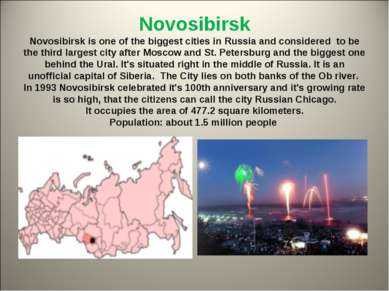
Novosibirsk Novosibirsk is one of the biggest cities in Russia and considered to be the third largest city after Moscow and St. Petersburg and the biggest one behind the Ural. It’s situated right in the middle of Russia. It is an unofficial capital of Siberia. The City lies on both banks of the Ob river. In 1993 Novosibirsk celebrated it’s 100th anniversary and it’s growing rate is so high, that the citizens can call the city Russian Chicago. It occupies the area of 477.2 square kilometers. Population: about 1.5 million people

Official symbols of Novosibirsk Coat of arms Silver black lace on a shield symbolizes cross-Siberian railway line. Number of merlons shows that Novosibirsk is a regional centre. Sables, bow and arrows are taken from a historical emblem of Siberia Flag Novosibirsk has its own flag . Green field means health and natural resources of Siberia ; white colour means cleanness and Siberian snow. Blue lace symbolizes the river Ob
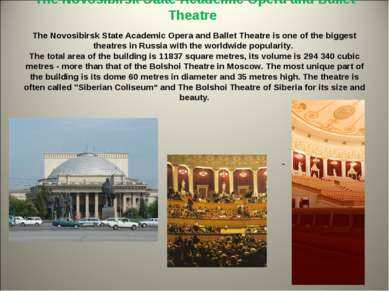
The Novosibirsk State Academic Opera and Ballet Theatre The Novosibirsk State Academic Opera and Ballet Theatre is one of the biggest theatres in Russia with the worldwide popularity. The total area of the building is 11837 square metres, its volume is 294 340 cubic metres — more than that of the Bolshoi Theatre in Moscow. The most unique part of the building is its dome 60 metres in diameter and 35 metres high. The theatre is often called «Siberian Coliseum“ and The Bolshoi Theatre of Siberia for its size and beauty.
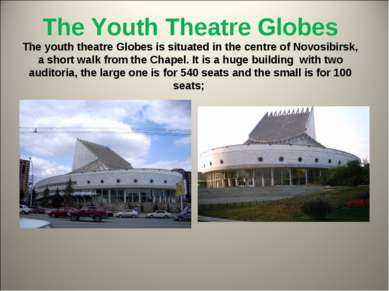
The Youth Theatre Globes The youth theatre Globes is situated in the centre of Novosibirsk, a short walk from the Chapel. It is a huge building with two auditoria, the large one is for 540 seats and the small is for 100 seats;
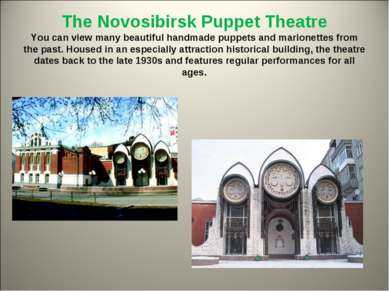
The Novosibirsk Puppet Theatre You can view many beautiful handmade puppets and marionettes from the past. Housed in an especially attraction historical building, the theatre dates back to the late 1930s and features regular performances for all ages.
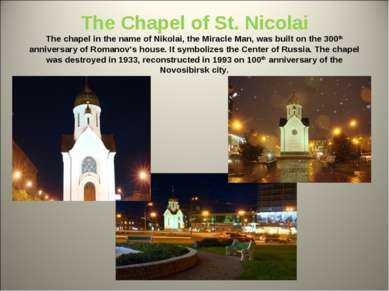
The Chapel of St. Nicolai The chapel in the name of Nikolai, the Miracle Man, was built on the 300th anniversary of Romanov’s house. It symbolizes the Center of Russia. The chapel was destroyed in 1933, reconstructed in 1993 on 100th anniversary of the Novosibirsk city.
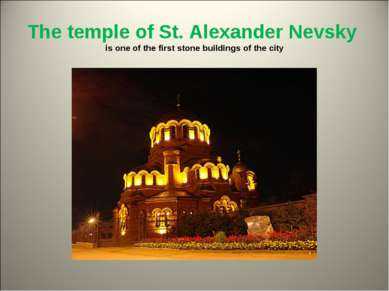
The temple of St. Alexander Nevsky is one of the first stone buildings of the city
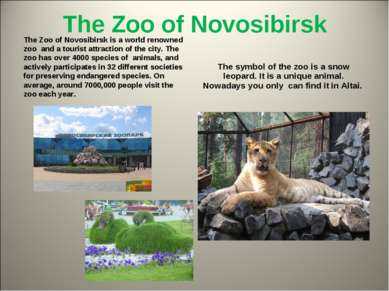
The Zoo of Novosibirsk The Zoo of Novosibirsk is a world renowned zoo and a tourist attraction of the city. The zoo has over 4000 species of animals, and actively participates in 32 different societies for preserving endangered species. On average, around 7000,000 people visit the zoo each year. The symbol of the zoo is a snow leopard. It is a unique animal. Nowadays you only can find it in Altai.
9 слайд
The Vauxhall of Novosibirsk «Novosibirsk-glavny» central railway station built in 1939 is a wonderful example of the so-called «imperial» architecture. The size of the building is 180 thousand cubic meters. It has the shape of a railway engine. Today it is still the largest in Siberia, and one of the largest in Russia.
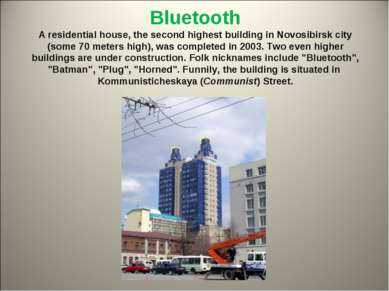
Bluetooth A residential house, the second highest building in Novosibirsk city (some 70 meters high), was completed in 2003. Two even higher buildings are under construction. Folk nicknames include «Bluetooth», «Batman», «Plug», «Horned». Funnily, the building is situated in Kommunisticheskaya (Communist) Street.
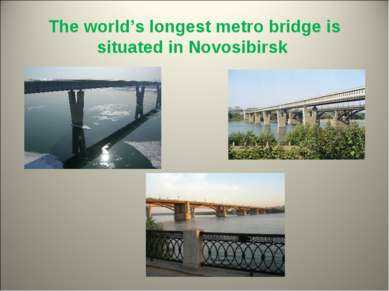
The world’s longest metro bridge is situated in Novosibirsk

Чтобы скачать материал, введите свой email, укажите, кто Вы, и нажмите кнопку
Нажимая кнопку, Вы соглашаетесь получать от нас email-рассылку
Если скачивание материала не началось, нажмите еще раз «Скачать материал».
338933389433895338963389733898339463401434048340603419734233
У вас есть презентация, загружайте:
Для того чтобы загрузить презентацию на сайт, необходимо зарегистрироваться.
uslide.ru
Вопрос: помогите мне пожалуйста! Мне срочно нужен рассказ про Новосибирск, на английском языке, с переводом. Заранее огромное спасибо!
помогите мне пожалуйста! Мне срочно нужен рассказ про Новосибирск, на английском языке, с переводом. Заранее огромное спасибо!
Ответы:
Novosibirsk is a city in Russia, administrative center of Novosibirsk region and the Siberian Federal district, a major industrial, transportation, scientific and cultural centre, is located in 3303 kilometers from Moscow. The city is located at the Priobskoye plateau adjacent to the valley of the river Ob, near the reservoir formed by the dam of the Novosibirsk hydroelectric power station. Novosibirsk is the largest city of Siberia and the largest municipality in Russia. Its population in 2006 is 1 million 397 thousand inhabitants. The largest Novosibirsk belongs to the third place in Russia after Moscow and St. Petersburg. The city covers an area of about 500,kV. km (50021 ha). Novosibirsk lies in the continental climate zone; the average annual air temperature is +0.2 C. Characterized by large fluctuations average (38 C) and absolute (88 C) temperatures. The average air temperature in January -18,8 C, in July +25 C. the lowest temperature was recorded on January 7, 1931 -50,2 C, the highest 22 July 1953 +37,2 C. the City is located at the intersection of forest-steppe and steppe natural zones. The settlement that later became the city of Novosibirsk, was founded in 1893 as the future site of a railway bridge over the Ob river. During its existence it changes its name several times. First, the place where the future city was New village, after she became a New village, which was later named Alexander, in honor of St. Alexander Nevsky, the heavenly patron of Emperor Alexander III. Since 1895, it was renamed the village of Novo-Nikolayevskoye in honor of St. Nicholas the Wonderworker, the patron Saint of Emperor Nicholas II. And in 1903, the settlement received the status of town. In 1925, the city of Novo-Nikolaevsk (after the October revolution, began to write the Novonikolaevsk) was renamed to Novosibirsk. The sights of Novosibirsk include the Opera and ballet Theatre, St. Nicholas chapel, Communal bridge, a railway bridge, monument to Marshal Pokryshkin and others. Новосибирск-город в России, административный центр Новосибирской области и Сибирского федерального округа, крупный промышленный, транспортный, научный и культурный центр, находится в 3303 километрах от Москвы. Город расположен на Приобском плато, прилегающих к долине реки Обь, недалеко от водохранилища, образованного плотиной Новосибирской ГЭС. Новосибирск-крупнейший город Сибири и самый крупный муниципалитет в России. Его население в 2006 году составляет 1 миллион 397 тысяч жителей. Крупнейший Новосибирский принадлежит третье место в России после Москвы и Санкт-Петербурга. Город занимает площадь около 500,кВ. км (50021 га). Новосибирск находится в Континентальной климатической зоне; среднегодовая температура воздуха +0.2 С. характерны большие колебания средней (38 C) и абсолютных (88 с) температурах. Средняя температура воздуха в январе -18,8 ° с, июля — +25 ° С. самая низкая температура была зафиксирована 7 января 1931 -50,2 C, самая высокая 22 июля 1953 года +37,2 Э. Город расположен на пересечении лесостепной и степной природных зон. Поселение, которое впоследствии ставший городом Новосибирском, был основан в 1893 году как будущего сайта железнодорожного моста через Обь. За время своего существования она меняет свое название несколько раз. Во-первых, место, где будущий город была новая деревня, после она стала новым поселка, который впоследствии назвали александровским, в честь св. Александра Невского, небесного покровителя Императора Александра III. С 1895 года его переименовали в поселок Ново-Николаевское (в честь святителя Николая Чудотворца, покровителя Императора Николая II. И в 1903 году поселок получил статус города. В 1925 году город Ново-Николаевск (после Октябрьской революции стали писать в Новониколаевске) был переименован в Новосибирск. Достопримечательности Новосибирска включает в театр оперы и балета, Никольская часовня, Коммунальный мост, Железнодорожный мост, памятник маршалу Покрышкину и другим.
cwetochki.ru
помогите мне пожалуйста! Мне срочно нужен рассказ про Новосибирск, на английском языке, с переводом. Заранее огромное спасибо!
Novosibirsk is a city in Russia, administrative center of Novosibirsk region and the Siberian Federal district, a major industrial, transportation, scientific and cultural centre, is located in 3303 kilometers from Moscow. The city is located at the Priobskoye plateau adjacent to the valley of the river Ob, near the reservoir formed by the dam of the Novosibirsk hydroelectric power station. Novosibirsk is the largest city of Siberia and the largest municipality in Russia. Its population in 2006 is 1 million 397 thousand inhabitants. The largest Novosibirsk belongs to the third place in Russia after Moscow and St. Petersburg. The city covers an area of about 500,kV. km (50021 ha). Novosibirsk lies in the continental climate zone; the average annual air temperature is +0.2 C. Characterized by large fluctuations average (38 C) and absolute (88 C) temperatures. The average air temperature in January -18,8 C, in July +25 C. the lowest temperature was recorded on January 7, 1931 -50,2 C, the highest 22 July 1953 +37,2 C. the City is located at the intersection of forest-steppe and steppe natural zones. The settlement that later became the city of Novosibirsk, was founded in 1893 as the future site of a railway bridge over the Ob river. During its existence it changes its name several times. First, the place where the future city was New village, after she became a New village, which was later named Alexander, in honor of St. Alexander Nevsky, the heavenly patron of Emperor Alexander III. Since 1895, it was renamed the village of Novo-Nikolayevskoye in honor of St. Nicholas the Wonderworker, the patron Saint of Emperor Nicholas II. And in 1903, the settlement received the status of town. In 1925, the city of Novo-Nikolaevsk (after the October revolution, began to write the Novonikolaevsk) was renamed to Novosibirsk. The sights of Novosibirsk include the Opera and ballet Theatre, St. Nicholas chapel, Communal bridge, a railway bridge, monument to Marshal Pokryshkin and others. Новосибирск-город в России, административный центр Новосибирской области и Сибирского федерального округа, крупный промышленный, транспортный, научный и культурный центр, находится в 3303 километрах от Москвы. Город расположен на Приобском плато, прилегающих к долине реки Обь, недалеко от водохранилища, образованного плотиной Новосибирской ГЭС. Новосибирск-крупнейший город Сибири и самый крупный муниципалитет в России. Его население в 2006 году составляет 1 миллион 397 тысяч жителей. Крупнейший Новосибирский принадлежит третье место в России после Москвы и Санкт-Петербурга. Город занимает площадь около 500,кВ. км (50021 га). Новосибирск находится в Континентальной климатической зоне; среднегодовая температура воздуха +0.2 С. характерны большие колебания средней (38 C) и абсолютных (88 с) температурах. Средняя температура воздуха в январе -18,8 ° с, июля — +25 ° С. самая низкая температура была зафиксирована 7 января 1931 -50,2 C, самая высокая 22 июля 1953 года +37,2 Э. Город расположен на пересечении лесостепной и степной природных зон. Поселение, которое впоследствии ставший городом Новосибирском, был основан в 1893 году как будущего сайта железнодорожного моста через Обь. За время своего существования она меняет свое название несколько раз. Во-первых, место, где будущий город была новая деревня, после она стала новым поселка, который впоследствии назвали александровским, в честь св. Александра Невского, небесного покровителя Императора Александра III. С 1895 года его переименовали в поселок Ново-Николаевское (в честь святителя Николая Чудотворца, покровителя Императора Николая II. И в 1903 году поселок получил статус города. В 1925 году город Ново-Николаевск (после Октябрьской революции стали писать в Новониколаевске) был переименован в Новосибирск. Достопримечательности Новосибирска включает в театр оперы и балета, Никольская часовня, Коммунальный мост, Железнодорожный мост, памятник маршалу Покрышкину и другим.
shpora.org
Рассказ на английском языке про город Новосибирск!Помогите!Пожалуйста!
Kisa2001ok
16 авг. 2016 г., 0:48:37 (2 года назад)
Novosibirsk is a city in Russia, administrative center of Novosibirsk region and the Siberian Federal district, a major industrial, transportation, scientific and cultural centre, is located in 3303 kilometers from Moscow.
The city is located at the Priobskoye plateau adjacent to the valley of the river Ob, near the reservoir formed by the dam of the Novosibirsk hydroelectric power station.
Novosibirsk is the largest city of Siberia and the largest municipality in Russia. Its population in 2006 is 1 million 397 thousand inhabitants. The largest Novosibirsk belongs to the third place in Russia after Moscow and St. Petersburg. The city covers an area of about 500,kV. km (50021 ha).
Novosibirsk lies in the continental climate zone; the average annual air temperature is +0.2 C. Characterized by large fluctuations average (38 C) and absolute (88 C) temperatures. The average air temperature in January -18,8 C, in July +25 C. the lowest temperature was recorded on January 7, 1931 -50,2 C, the highest 22 July 1953 +37,2 C. the City is located at the intersection of forest-steppe and steppe natural zones.
The settlement that later became the city of Novosibirsk, was founded in 1893 as the future site of a railway bridge over the Ob river. During its existence it changes its name several times. First, the place where the future city was New village, after she became a New village, which was later named Alexander, in honor of St. Alexander Nevsky, the heavenly patron of Emperor Alexander III. Since 1895, it was renamed the village of Novo-Nikolayevskoye in honor of St. Nicholas the Wonderworker, the patron Saint of Emperor Nicholas II. And in 1903, the settlement received the status of town. In 1925, the city of Novo-Nikolaevsk (after the October revolution, began to write the Novonikolaevsk) was renamed to Novosibirsk.
The sights of Novosibirsk include the Opera and ballet Theatre, St. Nicholas chapel, Communal bridge, a railway bridge, monument to Marshal Pokryshkin and others.
anglijskij-yazyk.neznaka.ru
Гиды и экскурсоводы Новосибирск — фото, отзывы, контакты, экскурсии Гиды и экскурсоводы Новосибирск
Зачастую отправляясь, в город Новосибирск мы хотим познакомиться с ее историко-культурным наследием. Как можно наиболее полно и качественно составить план экскурсий? Попробуем разобраться в вопросе. Если мы покупаем путевку у туроператора на родине, то мы можем выбрать экскурсии, предлагаемые им. В этом случае проведение экскурсий полностью берет на себя компания организатор тура. Если же вы самостоятельно изучаете страну, то можете воспользоваться услугами гидов уже на месте. Рассмотрим, как это сделать:
Представленные частные гиды в городе Новосибирск, как правило, это люди хорошо знакомые с местными достопримечательностями и имеющие историческое либо схожее гуманитарное образование. Правда, нередко на этом рынке попадаются мошенники и просто малоквалифицированные люди. Чтобы этого избежать стоит проверить у гида лицензию или же запросить диплом об образовании, также подойдут сертификаты различных туристических лиг. Неплохо будет посмотреть отзывы о гиде, к которому вы хотите обратиться, ведь тогда вы точно сможете понять, подходит он вам или нет.
Несомненно, вы с гидом разговаривали на одном языке! Предостережем вас от обращения к плохо-говорящему гиду. То, что вначале некоторым кажется милым и прикольным в процессе экскурсии перерастет в непонимание и впечатление от экскурсии по городу Новосибирск останется не лучшее.
Русскоязычный гид с должным уровнем языка, несомненно, расскажет вам намного больше, чем слегка говорящий по-русски. Найти такого гида можно в специализированных агентствах, так же там можно найти и наших соотечественников, подрабатывающих гидами, с которыми вы, несомненно, будете друг друга понимать. Найти такие агентства можно по вывеске Русский гид.
Популярные разделы сайта:
Купить Ж/Д билеты онлайн
Купить Авиа билеты онлайн
Гиды России для заказа экскурсий
Отели России для проживания
Смотреть вебкамеры России онлайн
www.personalguide.ru

.jpg)


